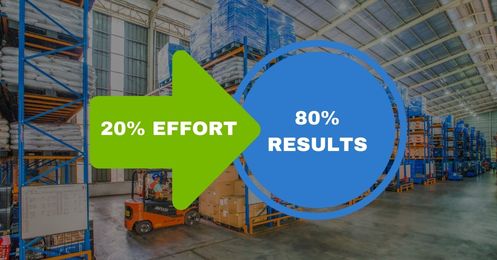In the late 19th century, an Italian economist named Vifredo Pareto noted that approximately 80 percent of the land in Italy was owned by 20 percent of the population. The core of the idea is this: the majority of results come from a minority of causes. 80 percent of our output comes from 20 percent of our input. This observation from Pareto, published in his first work Cours d'économie politique while at the University of Lausanne, is the foundation of the Pareto Principle or the 80/20 rule – a powerful concept now widely used by leaders and businesses around the world. By maximizing the power of the 20 percent providing the greatest gains, and by reducing the 80 percent that is problematic, leaders and businesses who adopt this concept are more efficient, effective and successfully increase the profitability of their organization.
So, how can we use the 80/20 rule (Pareto Principle) in our Supply Chain?
When using this principle to analyze business costs, most likely you will see that 20 percent of your cost categories are adding to 80 percent of your costs. If you can determine what’s in that 20 percent, you know what to target. Your next steps are to take action in those areas.
For example, let’s say you use the 80/20 rule and identify mistakes in your warehouse as being one of your top cost areas. You see that cost and think, "Ok, I'm going to reduce costs by minimizing mistakes in the warehouse." But, to use this principle effectively, don’t stop there. Use another Pareto analysis to examine the different types of mistakes and calculate how much each type costs. Are the mistakes related to picking the wrong product? Are the mistakes related to improper put-away processes and lost inventory? Are the mistakes related to manual processes and lack of automation? Most likely, you will again find that 80 percent of your mistakes are being caused by 20 percent of the problems, so the problems in that 20 percent are the ones to target.
The good news is that there won’t be many to tackle before you start to see progress. Using the Pareto Principle, out of 10 different types of mistakes identified in your warehouse, you’ll only need to focus on 2 types, the other 8 being all the small mistakes that only add up to 20 percent. Using this rule, it’s easy to see that there are a few underlying causes that are causing most of your problems.
How powerful is the 20 percent?
Let’s look further into these top 2 causes of mistakes in the warehouse. If you think about it, these 2 causes are not just 4 times as costly as the other 8. They are actually 16 times as costly. As they are only 20 percent, there are a quarter as many of them. Since they are worth 80 percent, they are actually 4 times as expensive in total, a factor of 16. In other words, if 2 of them cost $80 and the remaining 8 of them cost the remaining $20, then the first 2 are costing $40 each and the other eight are costing only $2.50 each. Clearly, it's very important to focus on those 2 causes.
Where to use the 80/20 Rule (Pareto Principle) to cut costs
To help use the 80/20 rule for cost savings, let’s look at 3 examples where you may be able to identify problems and reduce costs in your warehouse:
- Warehouse Layout. When you analyze your warehouse layout using the Pareto Principle, you might see that 20 percent of your warehouse gets utilized 80 percent of the time. Is this 20 percent optimized for the most efficient, picking, packing and shipping? Why is this area of the warehouse used more? Is it because it holds the most high-volume inventory? Is it where picking takes place? Packing? Consider options to make even more use of this space or expanding it to include more product and operational processes.
- Stock. This is another easy to identify area where Pareto applies. So, 80 percent of your stock costs (your money that's tied up in stock), probably comes from 20 percent of the items. What are those high-value items and are you selling enough volume to offset the costs? Ask yourself questions such as, can inventory management software help improve inventory turnover?
- Sales. 20 percent of your customers generate 80 percent of your revenue. Are you wasting time on customers that aren’t worth it? How can you keep the 20 percent of your customers happy? What types of products are these customers purchasing and how often? Although its never a good idea to only rely on a small number of customers for continued revenue growth, this type of information can help you direct resources and determine which customers to spend the most time with.
When trying to cut costs, it’s easy to become overwhelmed by the number of areas to consider and get distracted by fixing problems that won’t yield the best results. The Pareto Principle helps put cost savings in perspective and highlights effective areas of focus. Use the insights you gain to make the greatest impact on your business and then get ready to reap the rewards.










